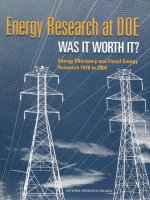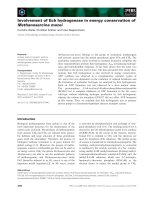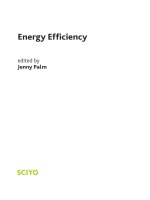Qualified Energy Conservation Bonds Notice 2012-44 docx
Bạn đang xem bản rút gọn của tài liệu. Xem và tải ngay bản đầy đủ của tài liệu tại đây (39.64 KB, 12 trang )
Notice 2012-44
Qualified Energy Conservation Bonds
PURPOSE
This Notice provides guidance concerning qualified energy conservation bonds
under § 54D of the Internal Revenue Code (Qualified Energy Conservation Bonds). This
Notice addresses questions regarding qualified conservation purposes eligible for
financing with these bonds, particularly (1) how to measure reductions of energy
consumption in publicly-owned buildings by at least 20 percent under § 54D(f)(1)(A)(i) and
(2) what constitutes a “green community program” under § 54D(f)(1)(A)(ii).
BACKGROUND
Section 301(a) of Title III of Division B, the Energy Improvement and Extension Act
of 2008, Pub. L. 110-343, 122 Stat. 1365 (2008) (the "2008 Energy Act"), added new
§ 54D, which contains program provisions specific to Qualified Energy Conservation
Bonds effective for obligations issued after October 3, 2008.
Section 54D(a) provides that the term Qualified Energy Conservation Bond means
any bond issued as part of an issue if: (1) 100 percent of the available project proceeds of
such issue are to be used for one or more “qualified conservation purposes;” (2) the bond
is issued by a State or local government; and (3) the issuer designates such bond for
purposes of § 54D. Section 54D(f) defines the term “qualified conservation purpose” to
include, among other purposes, capital expenditures incurred for purposes of (i) reducing
energy consumption in publicly-owned buildings by at least 20 percent, or (ii) implementing
green community programs (including the use of loans, grants, or other repayment
mechanisms to implement such programs). Section 54D(d) originally authorized a national
bond volume cap of $800 million for Qualified Energy Conservation Bonds, and § 54D(e)
generally provides rules for how this volume cap is to be allocated among the States.
Section 1112 of Division B of the American Recovery and Reinvestment Act of
2009, Pub. L. No. 111-5, 123 Stat. 115 (2009) ("ARRA"), amended § 54D in several
respects. ARRA increased the national bond volume cap for Qualified Energy
Conservation Bonds from $800 million to $3.2 billion. ARRA also amended the provision
on “green community programs” to what is in the statute today to clarify that these
programs may include the use of loans, grants, or other repayment mechanisms to
implement such programs. In addition, ARRA added § 54D(e)(4), which provides
generally that bonds issued to provide loans, grants, or other repayment mechanisms for
capital expenditures to implement green community programs are not treated as private
activity bonds for purposes of the restriction under § 54D(e)(3) against using more than 30
percent of the bond volume cap for private activity bonds.
In Notice 2009-29, 2009-1 C.B. 849 (April 6, 2009), the Treasury Department and
the IRS allocated the national bond volume cap for Qualified Energy Conservation Bonds
to States, the District of Columbia, and possessions of the United States in proportion to
population. Notice 2009-29 also provided interim guidance on certain general program
requirements under § 54D.
Section 179D also provides tax benefits for reductions in energy consumption in
government-owned buildings. Because of the difference in the rules and standards for
determining the deduction for energy-efficient commercial buildings under § 179D as
compared to the rules and standards for determining whether bonds are Qualified Energy
Conservation Bonds under § 54D, this Notice, including the rules for measuring the
reduction of energy consumption in publicly-owned buildings, does not apply for purposes
of § 179D. For guidance on § 179D, see Notice 2006-52, 2006-1 C.B. 1175, Notice 2008-
40, 2008-1 C.B. 725, and Notice 2012-26, 2012-17 I.R.B. 847.
2
LEGISLATIVE HISTORY
The legislative history of the 2008 Energy Act includes the House of
Representatives version of the 2008 Energy Act in a bill entitled the “Renewable Energy
and Job Creation Act of 2008,” H.R. 6049, 110
th
Cong. (2008) (H.R. 6049). The text of the
House Bill is identical, in pertinent part, to the text of the statute that was enacted. House
of Representatives Report No. 110-658 accompanied H.R. 6049 and indicates that the
House intended the Qualified Energy Conservation Bond rules to be interpreted broadly to
give State and local governments wide discretion on methods to conserve energy that may
be financed with Qualified Energy Conservation Bonds. The House Report states the
following reasons for enacting the Qualified Energy Conservation Bond provision:
Reasons for Change
The Committee believes that it is important to encourage energy
conservation. The Committee believes that State and local
governments often are in the best position to assess community needs
and recognizes there are a number of approaches to energy
conservation that State and local governments may wish to encourage.
For example, the Committee recognizes that State and local
governments may wish to encourage the development of combined
heat and power systems, facilities that use thermal energy produced
from renewable resources, smart electrical grids, the use of solar
panels, mass transit, bicycle paths, or residential property that reduces
peak-use of energy. In addition to these approaches, the Committee
believes that State and local governments will develop numerous other
approaches to energy conservation. Furthermore, the Committee
recognizes that there is great potential for energy conservation in
urban areas and the Committee believes that local officials should
have the flexibility to develop their own approaches to energy
conservation. Therefore, the Committee believes that it is appropriate
to empower State and local governments by providing them with
access to subsidized financing to help promote energy-efficient policies
tailored to the needs of local communities.
H. R. Rep. No. 110-658, at 94 (2008).
3
The legislative history of ARRA gives further indication of the broad discretion
Congress intended to give State and local governments issuing Qualified Energy
Conservation Bonds. The Conference Report, H. R. Rep. No. 111-16 (2009), provides:
Conference Agreement
In general
The provision expands the present-law qualified energy
conservation bond program. . . . Also, the provision clarifies that
capital expenditures to implement green community programs includes
grants, loans and other repayment mechanisms to implement such
programs. For example, this expansion will enable States to issue
these tax credit bonds to finance retrofits of existing private buildings
through loans and/or grants to individual homeowners or businesses,
or through other repayment mechanisms. Other repayment
mechanisms can include periodic fees assessed on a government bill
or utility bill that approximates the energy savings of energy efficiency
or conservation retrofits. Retrofits can include heating, cooling,
lighting, water-saving, storm water-reducing, or other efficiency
measures.
H. R. Rep. No. 111-16, at 627 (2009).
QUESTIONS AND ANSWERS
Numerous questions have arisen relating to Qualified Energy Conservation Bonds,
particularly how to measure whether there have been reductions of energy consumption in
publicly-owned buildings by at least 20 percent under § 54D(f)(1)(A)(i) and what
constitutes a “green community program” under § 54D(f)(1)(A)(ii). Set forth below are
questions and answers regarding certain of these interpretative issues. Issuers may rely
upon these answers until further guidance, if any, is provided.
CAPITAL EXPENDITURES FOR CERTAIN QUALIFIED CONSERVATION PURPOSES
Q 1. What are “capital expenditures” for purposes of § 54D(f)(1)(A), which
provides in relevant part that qualified energy conservation purposes include, among other
purposes, capital expenditures incurred for purposes of (i) reducing energy consumption in
4
publicly-owned buildings by at least 20 percent, or (ii) implementing green community
programs (including the use of loans, grants, or other repayment mechanisms to
implement such programs)?
A-1. For purposes of the capital expenditures requirement in § 54D(f)(1)(A), the
definition of a “capital expenditure” applicable to State and local governments for tax-
exempt bond purposes in § 1.150-1(b) of the Income Tax Regulations applies. This
definition provides that a “capital expenditure” means any cost of a type that is properly
chargeable to capital account (or would be so chargeable with a proper election or with the
application of the definition of placed in service under § 1.150-2(c)) under general Federal
income tax principles. The determination of whether a particular expenditure is a capital
expenditure is made when the expenditure is paid or incurred and future changes in law do
not affect this determination.
20% REDUCTION IN ENERGY CONSUMPTION IN PUBLICLY-OWNED BUILDINGS
Q-2. What does the term “publicly-owned buildings” mean under § 54D(f)(1)(A)(i)?
A-2. The term “publicly-owned buildings” under § 54D(f)(1)(A)(i) means a building
or buildings that are owned by a State or local government (as defined in § 1.103-1) or any
instrumentality thereof for Federal tax purposes. If the “measurement unit” (as defined in
Q&A 4 below) used to measure reductions in energy consumption is a unit other than a
building or buildings, such as a building system component, the building or buildings
encompassing the measurement unit must be a publicly-owned building or buildings.
Q-3. What standard applies to determine that available project proceeds are to be
used to finance capital expenditures for the purpose of reducing energy consumption in
publicly-owned buildings by at least 20 percent under § 54D(f)(1)(A)(i) (the “20 percent
test”)?
5
A-3. In general, a reasonable expectations standard (as defined for tax-exempt
bond purposes under § 1.148-1(b)) applies for purposes of determining reductions in
energy consumption under the 20 percent test. In particular, an issuer may determine that
its available project proceeds are to be used in a manner that meets the 20 percent test if,
as of the issue date of the issue of Qualified Energy Conservation Bonds, the issuer has
reasonable expectations (as defined in § 1.148-1(b)) that the capital expenditures to be
financed with the bond proceeds will result in a 20 percent or greater reduction in energy
consumption for the selected building, buildings, or building system component(s)
comprising the measurement unit for the selected measurement time period, and using a
common energy unit. See Q & A 4 (regarding measurement units), Q & A 5 (regarding
measurement methods), Q & A 6 (regarding measurement time periods), Q & A 7
(regarding reliance on certifications of independent experts), Q & A 8 (regarding certain
available tools for measuring energy reductions), and Q & A 9 (regarding common energy
units) below.
Q-4. What is the unit for which the issuer measures reductions in energy
consumption for purposes of satisfying the 20 percent test?
A-4. For purposes of the 20 percent test, the issuer may measure the reduction in
energy consumption using one of the following measurement units: (i) a single publicly-
owned building, (ii) multiple publicly-owned buildings; (iii) one or more building system
components of one or more publicly-owned buildings, or (iv) a combination of (i) or (ii) and
(iii) above (the “measurement unit”), provided that measurement unit includes the publicly-
owned building or buildings, or building system component or components,
with respect to
which the capital expenditures financed with Qualified Energy Conservation Bond
proceeds are incurred. For this purpose, a building system includes a system that serves
one of the following functions: heating, ventilation, and air conditioning (“HVAC”); hot water
6
system; lighting; building envelope (e.g., windows, roof, walls, insulation); or electricity
“plug load” (e.g., items plugged into electric outlets, such as computers and refrigerators).
Q-5. What methods may be used to measure energy savings attributable to capital
expenditures with respect to a measurement unit for purposes of the 20 percent test?
A-5. A reasonable and consistently applied method must be used to measure
energy savings attributable to capital expenditures with respect to a measurement unit for
purposes of the 20 percent test.
Q-6. What time periods may an issuer use to measure reductions in energy
consumption to meet the 20 percent test?
A-6. For purposes of the 20 percent test, the issuer may consider actual and
expected energy consumption in the measurement unit during any reasonable and
consistent time periods of not less than one year (the measurement time periods), with one
such period ending immediately before, and one such period beginning immediately after,
all capital expenditures to be financed by the Qualified Energy Conservation Bond
proceeds in the measurement unit are to be incurred, using a consistent method of
measuring energy use. For example, if the issuer selects measurement time periods of
two years, the issuer must determine its energy consumption in the measurement unit
during the two years immediately before the capital expenditures are to be incurred and
compare it to the energy consumption in the measurement unit during the two years
immediately after the capital expenditures are to be incurred (energy consumption during
the construction period is not considered), using the same method for measuring energy
consumption, to determine if it meets the 20 percent test.
Q-7. May an issuer rely on a certification of an independent expert to establish its
reasonable expectations to meet the 20 percent test?
A-7. An issuer may rely on an independent expert to establish that it reasonably
expects to meet the 20 percent test, if, no earlier than 60 days before the issue date of the
7
issue, an independent, licensed professional engineer or other independent expert certifies
under penalty of perjury that the capital expenditures to be incurred with respect to the
measurement unit are reasonably expected to result in the reduction of energy
consumption by 20 percent or greater in the measurement unit during the measurement
time period. An issuer may rely on this certification only if the actual capital expenditures
from the bond proceeds are substantially the same as the expected capital expenditures of
such proceeds on which the certification was based.
An example of an engineer’s certification for this purpose is attached as Appendix A
to this Notice.
Q-8. What tools are available to estimate the energy savings attributable to capital
expenditures for purposes of establishing that the issuer had reasonable expectations as
of the issue date of the issue that the capital expenditures will result in reduction of energy
consumption in publicly–owned buildings by at least 20 percent?
A-8. An issuer or an independent expert on whom an issuer relies may obtain
energy savings estimates through an ASHRAE level 3 audit or through building energy use
simulation techniques and estimating software, including the DOE (Department of Energy)
2 based Quick Energy Simulation Tool (eQUEST) or other qualified computer software for
calculating commercial building energy and power cost savings that meet federal tax
incentive requirements as listed by Department of Energy’s Building Technology Program
at: Further, an issuer or
independent expert may rely on other tools to estimate energy savings, using reasonable
and consistently applied methods.
An issuer is not required to subsequently measure the energy savings, but is
encouraged to employ energy management and monitoring practices, such as use of the
ENERGY STAR Portfolio Manager software to establish energy baselines and track whole
8
building energy performance. See
Q-9. How does the issuer determine the reduction of energy consumed in the
chosen measurement unit if more than one energy source affects the measurement unit
and the energy reduction is computed with respect to different types of energy sources,
such as electricity and natural gas?
A-9. If more than one energy source affects the measurement unit and thus is
taken into account in computing the reduction in energy consumption, the amount of the
consumed energy from each source before and after incurring the capital expenditures
must be converted into a common energy unit such as, for example, a MMBtu (one million
British thermal Units). In this circumstance, for purposes of the 20 percent test, the
percentage reduction in energy consumption is based on the percentage reduction for the
aggregate of the energy sources, using the common energy unit.
GREEN COMMUNITY PROGRAM
Q-10. What is a “green community program” under § 54D(f)(1)(A)(ii) for which
capital expenditures may be incurred as one of the qualified conservation purposes eligible
for financing with Qualified Energy Conservation Bonds?
A-10. In general, the term “green community program” means a program that
meets the following two requirements:
(1) Program Purpose
. The purpose of a green community program is to promote
one or more of the purposes of energy conservation, energy efficiency, or environmental
conservation initiatives relating to energy consumption, broadly construed. Eligible
program purposes include, among others, promotion of energy savings through retrofitting
initiatives for heating, cooling, lighting, water-saving, storm-water reducing, or other
efficiency measures; distributed generation initiatives; or transportation initiatives that
9
conserve energy and/or support alternative fuel infrastructure (which may include, for
example, improvements to public bicycle paths or mass transit systems).
(2) General Public Use or Broad Public Availability. A green community program
must: (i) involve property that is available for general public use (using standards similar to
standards for distinguishing general public use from private business use under § 1.141-
3(c)); or (ii) involve a loan (or other repayment mechanism) or grant program that is
broadly available to members of the general public, including individuals or businesses. A
green community program need not affect the entire geographical area or all the residents
and businesses within the jurisdiction of the State or local governmental unit that
implements the program, provided that the program broadly benefits the general public,
residents, or businesses in the affected area of the State or local governmental unit.
Examples of programs that are available for general public use include programs to make
improvements to public infrastructure that enhances proximity and connectivity between
community assets and public transit in order to reduce motor vehicle use and promote
energy conservation. An example of a loan or grant program that is broadly available to
the general public would be a program for residential housing or private building energy
efficiency initiatives that provides grants or loans that are broadly available for
homeowners or businesses.
Q-11. What is an example of a green community program?
A-11. The following example illustrates the implementation of a green community
program with proceeds of Qualified Energy Conservation Bonds. City, a large local
government, plans a program to finance capital expenditures to replace existing public
street lights located throughout the City with more energy-efficient lights within a 3-year
period. City recognizes the program as a green community program and designates the
bonds to finance the program as Qualified Energy Conservation Bonds under § 54D(a)(3).
Specifically, City plans to use the bond proceeds to replace existing high-pressure
10
11
luminaries with light emitting diode luminaries that consume substantially less electricity.
City’s independent experts estimate that the new streetlights will have a useful life of
approximately 15 years. As of the issue date of the bonds, City expects that the program
will result in substantial energy savings. City’s program qualifies as a green community
program that meets § 54D(f)(1)(A)(ii) for the following reasons:
1. The program furthers a qualified conservation purpose because it promotes energy
conservation. The program calls for the replacement of existing street lights with
more efficient street lights.
2. The program involves public streetlights that are available for general public use.
3. The proceeds of the bond will be used for capital expenditures within the meaning
of § 1.150-1(b) to replace the street lights.
FURTHER INFORMATION
For further information regarding this notice, contact Zoran Stojanovic at (202) 622-3980
(not a toll-free call).
APPENDIX A
Qualified Energy Conservation Bonds Statement of Expected Savings and Signatures
Qualified Professional Engineer certifying reasonable expectation of 20% or greater
savings using based on an ASHRAE Level 3 audit or through use of DOE-approved
software tool.
Name: __________________________
Address: ____________________________________________________________
Phone: __________________________
I certify that the expected percentage of energy savings from the capital expenditures financed
with Qualified Energy Conservation Bonds for the measurement unit and measurement time
specified by the issuer is at least 20 percent.
Address of the building(s) (and description of component(s), if applicable) to which the
certification applies:
_________________________________________________________________
___________________________________________________________________________
Qualified Professional Engineer must initial and complete one or more of the following
statements:
____ (1) I conducted an ASHRAE level 3 energy audit to estimate the expected savings from
planned improvements that will be financed through the qualified energy conservation bond.
____ (2) I used a qualified computer software for calculating commercial building energy and
power cost savings that meet federal tax incentive requirements as listed by Department of
Energy’s Building Technology Program to estimate the expected savings from planned
improvements that will be financed through the qualified energy conservation bond. The name
and version of the software is: ___________________________
Penalty of perjury statement to be signed by the Qualified Professional Engineer that
performs field inspections and generates certification form using qualified computer
software.
Under penalties of perjury, I declare that I have examined this certification, including supporting
documents, and to the best of my knowledge and belief, the facts presented in support of this
certification are true, correct, and complete.
Professional Engineer License # and State: ________________________________
Signature of Professional Engineer: ______________________________________
Date Signed: _________________________









